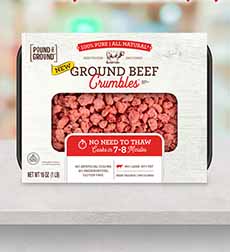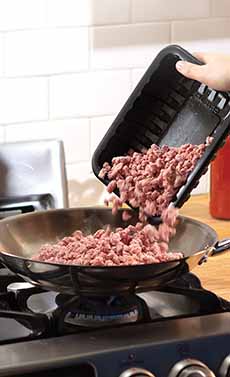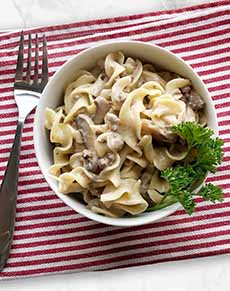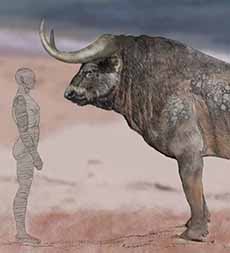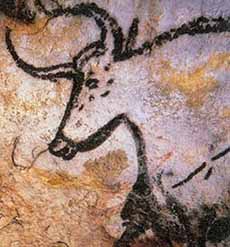Pound of Ground Crumbles Make Cooking Dinner A Cinch
|
Forgot to buy the beef? No problem. Forgot to thaw the meat? No problem. Only need a small amount? No problem. Pound Of Ground Crumbles® is here to solve the dinner dilemma. No worries! Pound of Ground was created by a working mom to help ease the dinner dilemmas of moms everywhere. Pound of Ground eliminates the need to thaw or plan ahead. The ground beef Crumbles sit snug in the freezer until you need them. Then, they go straight from the freezer to the stovetop and cook for 7-8 minutes. Why does it cook so quickly? Because small pieces cook faster. There’s zero thaw time. You just pour out the amount you need, and return the remainder to the freezer. A great feature of Pound of Ground Crumbles is that you can use as much or as little as you want. The remainder goes back to the freezer in a sealed bag. With Pound Of Ground Crumbles, there’s no: There are three varieties: Pound Of Ground is 100% pure all-natural (minimally processed, no artificial ingredients) frozen uncooked ground beef. Raw beef is ground and flash-frozen at peak quality. The beef comes from American cattle, harvested and produced in a single USDA-inspected facility in Michigan for product traceability. The brand was created to bring high-quality ground beef to consumers in a convenient form without sacrificing quality. A box or two in your freezer will make dinner a breeze. Pound of Ground was designed for favorite dishes that use crumbled meat like: > Here’s the store locator (look in in the frozen meat section). > Check out the company website. Humankind has been eating beef since prehistoric times. The ancestor of today’s cattle is the now-extinct auroch (images #5 and #6), the wild ox of Europe, a primitive bovine that is pictured in the earliest cave paintings. Aurochs were black in color, six feet high at the shoulder, and had forward-curving horns. They inhabited Asia, Europe, and North Africa The auroch was domesticated around 10,500 years ago, around 8000 B.C.E. Domesticated cattle were in demand not only for beef but for milk and leather. Wild aurochs were a popular beast to battle in the Roman arenas. They lived for many centuries beyond Roman times. However, they were overhunted and by the 13th century, the once widespread aurochs existed only in small numbers in Eastern Europe. The last recorded aurochs died in 1627. While the ancient ancestor of bovines is extinct, its DNA lives on in today’s domesticated cattle [source]. Fast-forward to the beginnings of America. Spanish explorers likely introduced the first longhorn cattle to America, roughly around 1534. Around 1623, British colonists brought Devon cattle. French and English colonists brought many new breeds across the pond, including Aberdeen Angus, Ayrshire, Charolais, Herefords, and Shorthorns, to name a few. Some of them were sought for dairying, others for their meat. Beef wasn’t a significant part of the American diet until after the Civil War. Prior to the Civil War, poultry and wild game were the main meats on American tables. Cattle were more widely used for dairy, butter, hides, and as draft animals. After the Civil War, cattle began to move further west with the population. Cattlemen discovered that many Spanish missions had already amassed large herds. |
|
|
|
The beef industry began to boom in the 1860s. Cattle breeding became a significant industry in the West, where food crops were more difficult to cultivate while there were plenty of native grasses were available for grazing livestock. Fattened cattle were transported by train to the midwest, where they were slaughtered and shipped via refrigerator cars to the East, where most of the American population lived. The Industrial Age saw the mechanization of the beef industry, in the raising, slaughtering, and processing of beef. The production line emerged, beginning with feedlots that were densely packed with cattle. As the feedlots became overcrowded, the need for heavy antibiotic usage* spiked to keep cattle healthy. Advances in bioengineering created synthetically grown hormones as well as steroids that could be used to increase beef output as well as dairy. Post-World War II, advances in bioengineering created synthetically grown hormones as well as steroids that could be used to increase beef and dairy output. But awareness of the means by which cattle were raised and handled led to the beginning of consumer demand for natural and organic beef. The incipient demand for organic beef by health-aware consumers began in the 1950s in response to ranchers giving growth hormones to cattle. It led to the modern awareness of the benefits of USDA-certified organic beef. In addition, the demand for better treatment of animals, for the health benefits of grass-fed as opposed to grain-fed beef, and for eco-friendly and environmentally conscious farming has grown as we learn more and more about our relationship with the ecosystem [source]. Grass-grazing, free-range cattle now live as the ancient aurochs lived. For those who can afford organic beef, it somewhat closes the loop to the healthier diets our ancestors knew. *The first antibiotic, arsphenamine, also known as Salvarsan, was introduced at the beginning of the 1910s. It was the first modern antimicrobial agent. Penicillin did not appear until 1941. †There is no USDA definition of “natural” as regards food products, including cattle. On the other hand, USDA Organic certification is highly regulated. It verifies that livestock are raised according to the USDA organic regulations throughout their lives. These include: (1) Unborn animals must be managed organically from the last third of gestation (mammals) or the second day of life (poultry). (2) Animals must be allowed year-round access to the outdoors except under specific conditions (e.g., inclement weather). (3) They must be raised on certified organic land meeting all organic crop production standards. (4) They must be raised per animal health and welfare standards. (5) They must be fed 100% certified organic feed. (6) They must be managed without antibiotics, added growth hormones, mammalian or avian byproducts, or other prohibited feed ingredients. CHECK OUT WHAT’S HAPPENING ON OUR HOME PAGE, THENIBBLE.COM.
|
||
